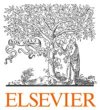
The ITC Faculty of the University of Twente has attained four spots in the Elsevier top 100 of most-downloaded papers in the field of Physical Sciences in the Netherlands. The ITC papers are found at 30, 36, 43 en 79 on the list. Seventeen ITC authors contributed to the list. Elsevier is the largest publisher of academic journals.
At 30 we find the article Spatial data for landslide susceptibility, hazard, and vulnerability assessment: An overview by Cees van Westen. This article has been downloaded 13,093 times and is about the research into databases with information on landslides. An overview is provided of the trends in collecting spatial information concerning environmental factors with a focus on, for instance, geology and soil, geomorphology and use of land.
At 36 we find the article Satellite remote sensing for water erosion assessment: A review by Anton Vrieling. This article was downloaded 12,209 times. Subject of the article is water erosion. Water erosion causes negative effects on agricultural production, infrastructure and the quality of the water around the world. At the regional scale, quality information is not readily available. This type of spatial information can be gathered with the help of satellites, and in that case the validation of this information is very important. A close collaboration between scientists in the field of remote sensing and in the field of erosion is necessary.
At 43 on the list we find the article Multi- and hyperspectral geologic remote sensing: A review by Freek van der Meer, Harald van der Werff, Frank van Ruitenbeek, Chris Hecker, Wim Bakker, Marleen Noomen, Mark van der Meijde, John Carranza, Boudewijn de Smeth and Tsehaie Woldai. This article was downloaded 11,325 times. The article provides an overview of multispectral and hyperspectral remote sensing data products and applications in geology. The most important threat to geological remote sensing is the lack of satellite data continuity. A unique opportunity lies in the possibility to develop standardized protocols that lead to validated and reproducible satellite remote sensing for the geological community. By focusing on geological maps, the geological remote sensing community can bridge the gap between them and earth scientists. Multidisciplinary collaborations occur more and more frequently, and remote sensing data has to be integrated with field observations and sub-surface geophysical data in order to understand and monitor geological processes.
Finally, at place 79 we find the article Modelling with stakeholders. Written by Alexey Voinov and Francois Bousquet. It was downloaded 9,043 times. Stakeholder engagement, collaboration, or participation, shared learning or fact-finding, have become buzz words. This is clearly a positive development, but in far too many cases stakeholders have merely been paid lip service and their engagement has consequentially been quite nominal. Better decisions are implemented with less conflict and more success when they are driven by stakeholders, that is by those who will be bearing their consequences. This article is about the different types of stakeholder modelling, and compares participatory modelling to other frameworks that involve stakeholder participation. Based on that and on the experience of the projects reported in this issue and elsewhere, the researchers draw some lessons and generalisations. They conclude with an outline of some future directions.

